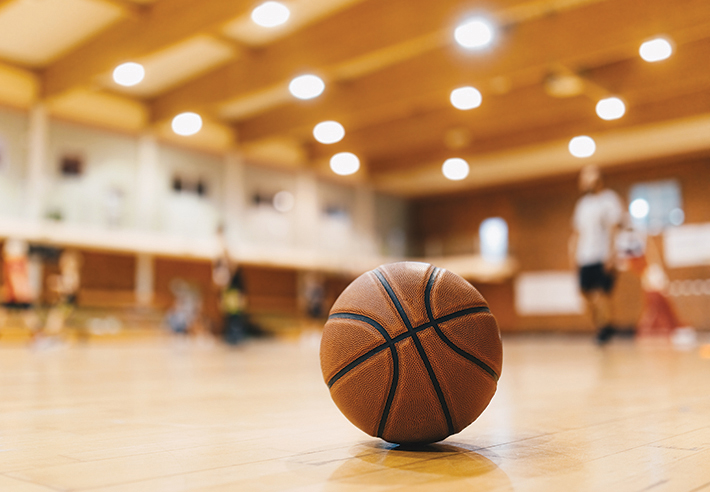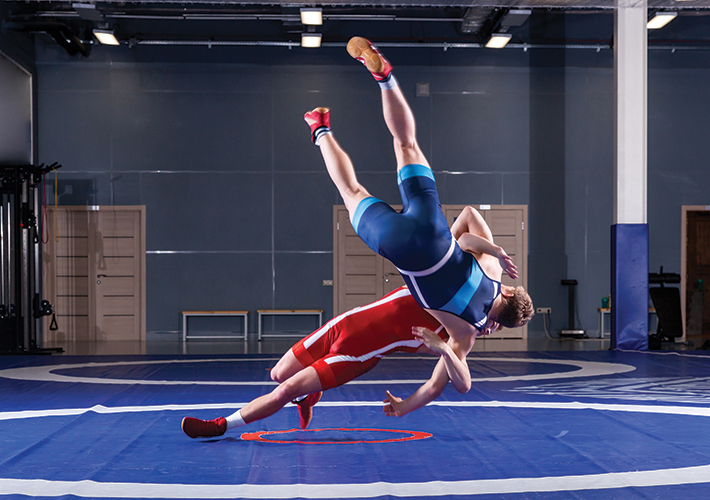
Standards Hit the Gym
For millennia, people have engaged in athletic pursuits. Ancient Egyptian monuments from 2400 B.C. depict the popularity of swimming and wrestling, while ancient Mesoamerican ball courts indicate a predilection for ball playing in 1600 B.C. Ancient Greece had the first dedicated space for physical training and athleticism. Dating back to 600 B.C., the ancient Greek gymnasium was where young men practiced running, wrestling, boxing, gymnastics, javelin, and discus. At the time, these activities were seen as ways to educate and prepare Greek youth for warfare.
The early 19th century saw the introduction of modern physical education by German gymnastics teacher Friedrich Ludwig Jahn, who emphasized the importance of developing physical as well as mental prowess. As in ancient times, Jahn stressed the need for increased fitness in anticipation of future conflicts.
By the mid 1800s, North Americans began to recognize the value of gymnasiums as well as physical education and introduced classes aimed at making students stronger and more fit. Interest in physical fitness and education would accelerate during the 1960s, when President John F. Kennedy launched the White House Committee on Health and Fitness and the annual Youth Fitness Congress.
READ MORE: Playing Hardball with Standards
However, with increased physical activity came increased opportunities for injuries, particularly in school settings. The National Safety Council reported that in 2021, U.S. children ages 5 and above experienced over 1.7 million sports-related injuries that required emergency room visits. Basketball had the most injuries with kids ages 15 and older, while football had the most for those ages 5 to 14. Sprains were a common affliction but muscle and ligament tears and bone fractures and dislocations were also prevalent. The sources of these injuries included students running into each other, into gym equipment, or into the gymnasium itself, the absence of trained instructors and supervision, and technical failures.
In terms of equipment, gymnasiums possess an array of possible hazards, including basketball backboards and backstops, wrestling mats and mat lifters, and divider curtains. In 2013, a Georgia high school student died when he became trapped in a rolled-up gym mat, and in 2016, a Missouri high school senior sustained fatal injuries when a basketball backstop struck him.
Slam Dunk for Basketball Standards
ASTM International’s committee on sports equipment, playing surfaces, and facilities (F08) has several work items in production to help make school gymnasiums safer and minimize the risk of life-threatening injuries. Among them is the new specification for ceiling and wall suspended basketball backstops (WK70498). Backstops attach to the back of a backboard — a 42-inch, vertical, flat board made of high-density polyethylene (HDPE), polycarbonate, acrylic, or tempered glass to which a basketball rim and hoop are affixed — and provide stability and support to it.
“A number of manufacturers of institutional athletic equipment for gymnasiums felt there was a need to develop a standard, or guide, to help ensure the safety of all individuals who use sports facilities, in particular those with athletic equipment that is mounted and stored up in the ceiling,” says Wayne VanBenschoten. He is the vice-president of engineering at Jaypro Sports LLC and technical contact for the work item. “We wanted to set some industry standards for safety in manufacturing, installation, and maintenance, and also provide assistance to architects, designers, and specifiers in selecting equipment that is important from a safety standpoint. We also wanted to assist in laying out the gymnasium, to make sure that equipment isn’t colliding when folding up or interfering with each other. Control systems are another factor. A control system should be positioned inside the gymnasium instead of in a control or electrical room. The operator should have a clear view of the equipment and be able to hear the equipment as it’s being operated. The person shouldn’t just turn the switch on and leave.”
Created by the subcommittee on commercially-installed sports-specific equipment for use in public venues (F08.69), the new specification for backstops will feature welding standards, strength requirements for attachment clamps and hardware, and a fall-arrest system. A fall arrest is a large, weighted safety strap that, in the event of a cable loosening or giving way, catches the backstop and stops it from falling onto players, spectators, and the gym bleachers or floor.
VanBenschoten notes that, up to this point, it has been left to the architect’s discretion whether to include a fall arrest or not. If an architect is not involved in the equipment selection, an organization may elect not to have a fall-arrest system. VanBenschoten says that the institutional athletic equipment industry feels strongly that fall arrests should be placed on all backstops.
Created in parallel to the basketball backstop specification, the new guide for service and maintenance of ceiling and wall suspended basketball backstops (WK70499) emphasizes the need for sports facility owners to have their equipment regularly serviced. The guide also looks at what things should be inspected, how frequently inspections should happen, and the replacement of old or faulty equipment. Presently, no such guide exists.
“Maintenance is very important,” says Neal Turner. He is the director of gymnasium equipment sales at Draper, Inc., chair of subcommittee F08.69, and member of the sports facilities (F08.66) and gymnastics and wrestling equipment (F08.12) subcommittees. “You have a mechanical piece of equipment hanging up in the air that weighs thousands of pounds and hangs over peoples’ heads. Because it’s mechanical, there are points that can wear and hardware that can loosen due
to vibration.”

Standards for hoists for wrestling mats are currently planned for the future.
Ideally, maintenance would take place on a yearly basis to guarantee that cables, pulleys, bolts, and other hardware are securely in place. “Accidents typically don’t happen quickly on gym equipment. It’s something that you probably could have detected if you were staying on top of your maintenance,” Turner says.
Beyond Basketball
Another work item from F08.69 that pertains to basketball as well as other gymnasium activities is the new terminology for relating to commercially-installed, sports-specific equipment for public venues (WK78953). Periodically, the athletics industry will apply the same term to different sports and equipment uses. For example, in basketball a backstop refers to the mechanism providing support and stability to a backboard, while in baseball, a backstop is the fence behind home plate that keeps the ball from going into the spectators’ area. The new terminology aims to avoid confusion and the need to define the same term in multiple standards.
The subcommittee’s focus on basketball is due in part to the prevalence of the sport in school and public gymnasiums. “Basketball is the most common product in gymnasiums. When you look at the quantities, a gym might have six basketball backstops. Some fieldhouses can have 30 to 40 backstops,” VanBenschoten says.
According to Turner, basketball rigging largely employs the same parts and pieces as rigging for volleyball, ceiling-suspended batting cages, and gym dividers. “There are just different loads on it. So once you cover one product, it helps down the road with standards for the other products,” he says.
Wall padding is one such gymnasium product that has helped to initiate standards for other products. In 2004, the subcommittee on gymnastics and wrestling equipment (F08.12) released the standard specification for indoor wall/feature padding (F2440). Indoor wall padding protects players who might careen into a wall when participating in such sports as basketball, volleyball, wrestling, and gymnastics. “Featuring padding” would be the padding placed on a steel post, column, or other facility-related structure.
The standard details the construction and physical properties of both permanent and removable wall paddings. Padding thickness, shock absorption, and GMAX and HIC tests, which measure impact, are among the physical properties discussed in F2440. It has set the benchmark for shock absorption of wall pads and driven the use of better foam in wall padding.
“It was a big step for the industry when the subcommittee undertook that specification. F2440 was a stepping stone that helped us to think about other products as well. In a way, it was what prompted the current group [F08.69] to look at ceiling-mounted standards,” Turner says.
Currently, the indoor wall/feature padding standard is undergoing revision to include minimum sample requirements and sample locations for impact testing.
“F2440 achieves a minimum level of safety that we know all facilities will have, and we have not seen a rash of injuries,” says Paul Elliot. He is the president of ASET Services, a professional engineer, and a member of F08.12. “Today, there are a lot of pads that greatly exceed the GMAX and HIC of 200 and 1,000 that are required.”
In the future, there will be a separate wall-padding standard for outdoor sports such as baseball, track, and soccer. “In my opinion, we have significantly different biomechanics at play with baseball. In baseball, the wall is considered part of the playing field. Baseball players will run to catch the ball and hit a wall at top speed, while basketball players know they should not hit the wall and try not to hit it. To pass the standard [F2440], manufacturers will have to make the indoor wall pads a lot firmer. If you make a baseball wall pad that firm, you create a danger with the velocities the players reach,” Elliot says.
An Installation Standard – And Other Product Guides
Once the work on the basketball backstop specification and maintenance standards has ended, the subcommittee on commercially-installed sports-specific equipment anticipates creating a guide with recommended best practices for installing backstops.
“There was a lot of discussion among the task group on which to address first: How to install the equipment or how to maintain the equipment. We came down on the side of maintenance because there is so much old equipment out there and we felt it was really important to prioritize it and get this equipment maintained and serviced,” VanBenschoten says.
FOR YOU: Safer Sports and Play – Turf and Bicycles
In some cases, gymnasium equipment can be left in place for up to 30 years.
In his 34 years working in this field, the most common failure Turner has seen has involved the improper installation of wall-mounted backstops. When incorrectly installed, the backstop could detach and fall to the ground, injuring players and anyone nearby. And unfortunately, improper installation is not always obvious. An error or oversight might not be apparent until after an accident has occurred.
Along with creating installation guides, the subcommittee hopes to turns its attention to other gymnasium products. VanBenschoten expects there will be guides for gymnasium curtains, batting cages, volleyball, and wrestling hoists, which lift up and store wrestling mats at ceiling level. He notes that the somewhat diverse nature of these products is driving the desire to write separate standards.
For additional information about or to join the committee on sports equipment, playing surfaces, and facilities or any of its subcommittees please contact staff manager Joe Koury at jkoury@astm.org. ■
Kathy Hunt is a U.S. East Coast-based journalist.
 SN Home
SN Home Archive
Archive Advertisers
Advertisers Masthead
Masthead RateCard
RateCard Subscribe
Subscribe Email Editor
Email Editor